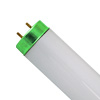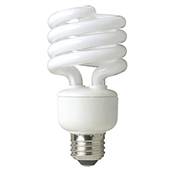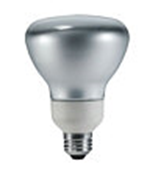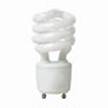|
What is Happening to Lighting Today?
Part 3 - Fluorescent Lighting
Contributed by Mel Amundson
Linear Fluorescents
If you thought about upgrading the fluorescent lighting at your facility, changes to the federal efficiency standards for linear fluorescent lighting are forcing your hand..

The Energy Policy Act (EPACT) of 2005 and the Energy Independence and Security Act (EISA) of 2007 are two energy legislative regulations enacted to establish energy reduction targets for the United States. This has significant impacts on lighting technologies, specifically linear fluorescent lamps, since the minimum efficacy (lumens per watt) standards have increased. This increase has effectively eliminated the production of all T12 fluorescent technologies as well as the original T8 fluorescent lamps. T12 lamps and magnetic ballasts are considered outdated compared to today’s T8 and T5 fluorescent technologies.

First, effective in 2010, T12 magnetic ballasts are no longer to be manufactured or imported for sale. As a result of this federal regulation, the only type of ballast available for purchase for T12 lamps is an electronic ballast. In addition, effective July 14, 2012, all linear fluorescent lamps manufactured or imported for sale in the U.S. must meet more stringent efficacy standards.
You can still buy T12 lamps, until the available supply is exhausted. However, the price of T12 lamps has been increasing as the supply diminishes. The effect of the new standards may vary depending on where you are located, the total number of T12 lamps in use, availability of replacement lamps, stringency of energy codes and other factors. Also, please note that there are a few types of T12 lamps in the market that currently meet the new efficacy standards.
About upgrading your T12 lamps. Most incentives that were available through government programs have expired. So the energy savings is the driving force for current changes. With the change out of T12 lamps and magnetic ballasts significant dollar saving can be achieved through your customer’s utility costs. The most popular change out is to T8 lamps and hi-efficiency electronic ballasts. The newer T8 technologies create better quality light and give off less heat, reducing air conditioning cooling loads. New lighting requires little to no maintenance for more than 24,000 hours of operation, lasting up to twice as long as T12 lamps, reducing maintenance costs associated with lamp changes.
 The new lighting standards are leading to large amounts of retrofit work. The installed T12 lighting systems represent millions of lamps for lamp and ballast changes, as well new lighting level standards, all are potential areas for electricians and electrical designers. The new lighting standards are leading to large amounts of retrofit work. The installed T12 lighting systems represent millions of lamps for lamp and ballast changes, as well new lighting level standards, all are potential areas for electricians and electrical designers.
 
Compact Fluorescent Lights
 The good and bad about CFL’s The good and bad about CFL’s
The residential customer has been slowly moving into the compact fluorescent market. They can no longer buy the incandescent lamp, and as they replace fixtures, the replacement fixtures have a bi-pin base that will only accept CFLs. They also recognize environmental issues that are moving us to more efficient energy use, and as part of the issue is also the need to save money as all of our electrical bills continue to rise.
 The early CFLs suffered from several problems, one of which is shown, in early markets the growing pains are easily seen. The first CFLs had few instructions, or poorly stated ones, leading to overheating as we replaced bulbs in existing fixtures with poor ventilation. They were also known for slow warmup to full brightness. As well as the early CFLs produced a light color we commonly called cool-white, which was fine in a factory or garage, but not in the home or a business where color is more critical. The Color Rendition Index (CRI) is now used to measure a light source's ability to render colors the same way sunlight does. The top value of the CRI scale (100) is based on illumination by a 100-watt incandescent lightbulb. A light source with a CRI of 80 or higher is considered acceptable for most indoor residential applications, full-spectrum CFLs have CRIs >90. The early CFLs suffered from several problems, one of which is shown, in early markets the growing pains are easily seen. The first CFLs had few instructions, or poorly stated ones, leading to overheating as we replaced bulbs in existing fixtures with poor ventilation. They were also known for slow warmup to full brightness. As well as the early CFLs produced a light color we commonly called cool-white, which was fine in a factory or garage, but not in the home or a business where color is more critical. The Color Rendition Index (CRI) is now used to measure a light source's ability to render colors the same way sunlight does. The top value of the CRI scale (100) is based on illumination by a 100-watt incandescent lightbulb. A light source with a CRI of 80 or higher is considered acceptable for most indoor residential applications, full-spectrum CFLs have CRIs >90.
Okay: Why CFLs today
CFLs are four times more efficient and last up to 10 times longer than incandescent. A 22 watt CFL has about the same light output as a 100 watt incandescent. CFLs use 50 - 80% less energy than incandescents. Although initially more expensive, you save money in the long run because CFLs use 1/3 the electricity and last up to 10 times as long as incandescents. A single 18 watt CFL used in place of a 75 watt incandescent will save about 570 kWh over its lifetime. At 8 cents per kWh, that equates to a $45 savings.
Newer CFLs give a warm, inviting light instead of the "cool white" light of older fluorescents. They use rare earth phosphors for excellent color and warmth. New electronically ballasted CFLs don't flicker or hum. And the new ballasts also, produce less heat and provide higher starting voltages, for faster startup to full level lighting.
A few limitations to the use of CFLs are: The principle reason for reduced lifespan of CFLs is still heat. CFLs exhibit shorter lifespans in light fixtures and sockets where there is low air-flow and heat build-up such as recessed lighting. Another main reason for reduced lifespan of CFLs is too-frequent on/off cycling. These bulbs should be used where they will be left on for steady periods without being flicked on and off. Dimmable CFLs are available for lights using a dimmer switch, but check the package, not all CFLs can be used on dimmer switches.
Next article: Are you ready for LED lighting?
This is a 5-part series on residential and commercial lighting.
Mel Amundson, President of Amstar, is a noted presentor, author, and consultant in the electrical industry. Contact him at: 812.457.1916 or mel@amundson.net
|



